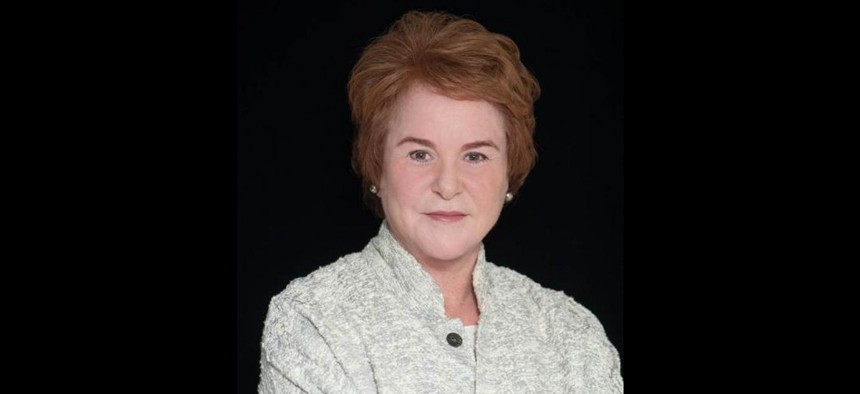Ticktock: How the $2.1B Vectrus-Vertex merger came to be

Mary Howell has been named chair of V2X, the new company created by the merger of Vectrus and Vertex. Courtesy of Vectrus
A new public filing reveals both the combined company's new name and the transaction's inner workings.
Although more decisions are to be made, they at least have a name, a board chair, and a general location for their headquarters once Vectrus and Vertex merge later this year.
The combination of Vectrus and Vertex was announced in March and put a value of $2.1 billion on Vertex. The merger of the two companies creates a company with $3.4 billion in annual revenue and 14,000 employees.
The new entity will become "V2X" and will be headquartered in Northern Virginia at closing or shortly thereafter. The closing is expected sometime in the third quarter of this year.
A more specific location is still to be determined and agreed upon by both companies. The combined 11-member board of directors will break the tie if no consensus can be found.
Designated as chair of the board is Mary Howell, a member of the Vectrus board since it opened for business in 2014 after spinning off from then-parent Exelis. Howell was an executive vice president at Textron from 1995 until her retirement in 2009 and currently leads her own international consulting firm.
The decisions on the name and new board chair were revealed in a proxy filing posted Wednesday by Vectrus, which explains to its investors nearly everything about the transaction and details on how it came about.
We clipped out the relevant 17 pages here that detail much of the behind-the-scenes activity and they begin with then-L3 Technologies' process to find an acquirer for Vertex Aerospace in 2018.
Vectrus showed some initial interest but decided to not proceed given other high-priority items, including its defense of a recompete that both became part of the Army's $82 billion LOGCAP V logistics contract and a significant hurdle cleared.
L3 ended up selling the Vertex business to American Industrial Partners, the private equity firm that will hold 62% of the stock in what will be V2X with Vectrus' investor base owning the other 38%.
AIP supported Vertex's acquisition of the former Raytheon Technologies global training and logistics services unit that completed in October of last year.
Vectrus twice showed some interest in potentially acquiring that business: both in an October 2020 communication to a member of Raytheon's management team and again in March 2021. The latter came after a notification from Raytheon's financial adviser that a process to sell that business would be in-the-works.
One month after that message from Raytheon: Vectrus again decided to focus on its own business plan and look at other acquisition opportunities as they arise. Vectrus did complete two transactions on New Year's Eve in 2020: Zenetex and HHB Systems.
Sure enough: another publicly traded government services company similar Vectrus and called "Party A" in the came calling in the first quarter of 2021 to discuss an all-stock merger of both entities.
Vectrus' senior management team and its board decided to explore the merger. Some discussions and limited mutual due diligence took place with the input and participation of financial and legal advisers.
Those talks ended in early October after it became apparent that neither Vectrus or Party A were on the same page regarding how stock in a combined company would be distributed among the shareholders. Later that same month: Party A announced a transaction of its own with "an unrelated third party."
Fast forward to Oct. 26: a financial adviser of Vertex contacted an executive at Vectrus to gauge interest in a transaction involving both entities. One day later, the adviser shared some financial information with Vectrus' senior management team.
Our reading of the proxy points to Nov. 18 as the first meeting that got into the high-level nature of what a potential merger of the companies would look like. In attendance were members of Vectrus' senior management team and their counterparts at American Industrial Partners, the then-owners of Vertex.
Vectrus' board on Dec. 1 decided the discussions with AIP should go on, plus also agreed to talk through potential steps after receiving a written proposal five days later.
That proposal laid out a 65-35% stock ownership split in AIP's favor. But in a Dec. 20 telephone call with AIP Partner Joel Rotroff, Vectrus CEO Chuck Prow said the latter's board was looking for its shareholders to own 40% of the combined company's stock.
AIP's next proposal followed later that day with a revised ownership structure: they would hold 58-to-65% of the equity with Vectrus stockholders at 35-to-42%. Another proposal followed with that same structure but without a request for an exclusivity agreement until Feb. 18, 2022.
More internal and external meetings followed between the companies and their advisers, then Vectrus gave its written proposal that put forth a 59-41% stock ownership split still in the favor of AIP.
AIP's financial advisers on Feb. 14 followed with a summary to Vectrus advocating again for the 65-35% ownership split. Three days later: Vectrus' board told its financial advisers to tell AIP that a 61.5-38.5% ownership split could be up for discussion.
Feb. 21 seems to be where they settled on the final range: 62.25 percent for AIP and 37.75 percent for Vectrus' stockholders to be exact.
All the final communication and work needed to get a merger agreement signed and executed followed.
Then Vectrus and Vertex announced their plan to join forces on March 7.


